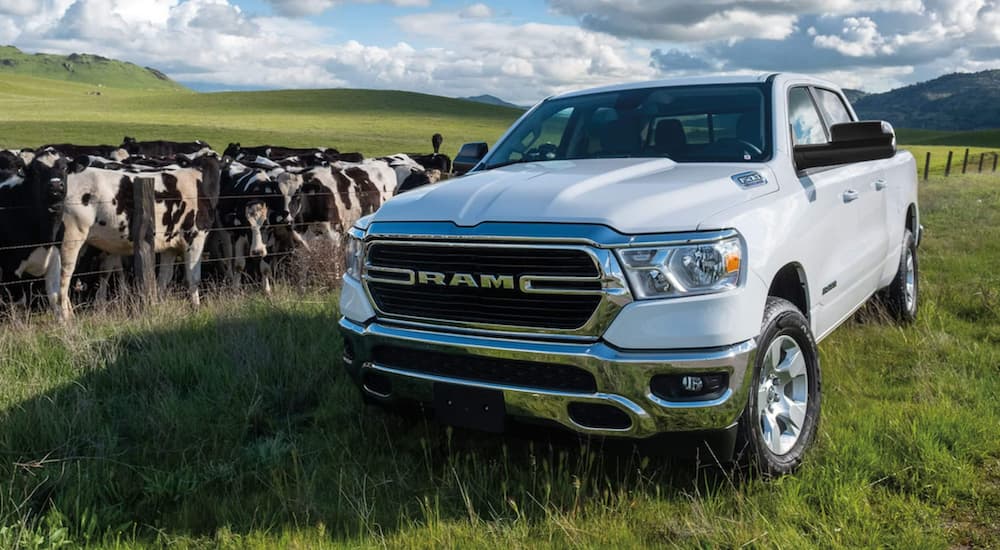Proper car care can mean a lot of different things; it can be as simple as checking your tire tread depth once a month and making sure your turn signal lights are working, or as elaborate as rebuilding an engine. One of the simplest ways to care for your own vehicle, and skip a trip to your dealership or local mechanic, is changing the oil on your car, truck, or SUV. Although the overall steps are pretty much the same regardless of your vehicle, today, I’m going to take you through how to change the oil on a 2021 Ram 1500 pickup. The good news is that this is pretty simple, and after you do it once, you’ll be able to do it again very easily.
Step One: Getting What You Need
Before you start messing around with your engine, the first thing you should do is get everything you need ready and in place. The last thing you want is to have your truck sitting there with no oil and realize you need to run to the store for something to finish up. Don’t do that.
You’ll need:
- New oil (I’d definitely recommend full synthetic)
- A new oil filter (Go with a MOPAR filter to be safe)
- 13mm socket and ratchet
- Strap wrench or band clamp
- Oil catch basin (make sure it’s big enough)
- Funnel
- Rags and/or paper towels
- Rubber gloves
Do you absolutely need to wear gloves? Not necessarily, but motor oil isn’t exactly good for your skin. Plus, if you should get a large cut while changing your oil (accidents happen) and get some motor oil in it, then cleaning that out is going to be one of the least fun moments in your life. So wear gloves – just make sure they fit well, so you don’t snag them on anything and you can easily control what you’re doing.

Step Two: Drain the Old Oil
Get your Ram 1500 parked securely on a level surface and set the parking brake because you’re going to start off by getting on the ground under it. To make your life easier, you can lift it up on jack stands or ramps, but these trucks are big enough that usually isn’t necessary. Then, get your 13mm wrench and oil basin and get down under the front-end of your truck.
You’ll find the drain plug on the underside or bottom of your engine oil pan, and it should be toward the passenger side. It might take a little bit of looking around down there, so remember to bring a flashlight, but you’ll find it easily enough. Your 13mm wrench should fit onto this (don’t force it if it doesn’t – the original plug might have been replaced with something else during a previous oil change) and allow you to remove the plug in order to drain the old oil from your vehicle.
Make sure you have your basin ready and in position to catch the oil. Once you remove the plug, just let it all drain out – it should only take a few minutes. After it’s fully drained, wipe off the area with a rag or paper towel to clean off any oil, then replace the plug and tighten it back into place using the wrench. Don’t over-tighten it – you can easily strip the plug and create a real problem for yourself.
Step Three: Change the Oil Filter
This part is going to be pretty awkward because the position of the oil filter on the Ram 1500 is not particularly user-friendly for any of the three engines. If you have the 5.7L HEMI in your truck, you will find the oil filter on the lower part of the engine, on the passenger side, pretty much right above the front axle of your truck. If you have the 3.6L Pentastar or the 3.0L Ecodiesel, then the oil filter will be located on the upper half of the engine and should be accessed from the top. However, they are still buried deep in the engine bay.
Since they are all hard to get to, removing the filter can be tricky – when it’s factory-tightened, it can really be an ordeal. You still might need a strap wrench or a band clamp to get a good grip on it and remove it, but it may be possible just using your hand. Excess oil will spill out when you remove the oil filter, so be ready for that.
Once you remove the old oil filter, then get your new oil filter and rub a little fresh motor oil along its gasket or rubber seal to ensure a good fit. Then simply attach the new oil filter right where the old one was and hand-tighten it. Using a wrench can damage the filter and makes it a lot harder to get off in the future. You’ll then want to clean up any oil that spilled out while you were doing this before you continue.
Step Four: Fill with New Oil
Still with me? Great, because you’ve pretty much done all the dirty work. Now, you can locate the cap for your engine oil fill and remove it – you should be able to find it on the right side of the top of your engine. Simply unscrew the cap, then pour new oil into the engine using your funnel to avoid any spilling. Once you refill your engine with oil, then replace the filler cap and tighten it by hand to ensure that it’s secure.
If you’re not sure which kind of oil you need, it will clearly be printed on your truck’s filler cap, and your owner’s manual will have more detailed information. These are the types and quantities of oil the three engines take:
- 3.6L Pentastar V6 – 5 Quarts of API Certified SAE 0W-20
- 5.7L HEMI V8 – 7 Quarts of API Certified SAE 5W-20
- 3.0L Ecodiesel – 8.5 Quarts of 5W-40 synthetic
For the gasoline engines, Ram recommends Mopar, Pennzoil, Shell Helix, or other oils meeting FCA Material Standard MS-6395. For the diesel engine, the appropriate standard is MS-12991.

Step Five: Run Your Engine and Top-Off
You’re pretty much done at this point, but two final things will help ensure your truck runs beautifully. First, start your engine and let it run for 15 or 20 seconds. This will get the new oil warmed up and moving throughout your engine. Then, turn off your engine, wait a little bit for it to cool down, and then check your oil level using the dipstick. This will ensure you have enough oil in your engine. You can do this a few times to be sure your engine is good and full. Just use the measurement on the dipstick and get it to the sweet spot.
Step Six: Reset the Oil Life System
Finally, you should reset the Oil Life system that your Ram truck uses to track when you need to change your oil. You can do this by putting the truck into ON/RUN by pushing the engine start button without pressing down on the brake pedal. Now, press the down arrow on your steering wheel to get your driver display to the “Vehicle Info” menu.
From there, scroll right until you select the “Oil Life” screen. Once you have found it, hold the “OK” button to reset the system. This should reset the Oil Life to 100%, so you’ll be able to track when you need to change your oil again. Then simply press the up arrow to get back to your usual driver display screen.
Step Seven: Pat Yourself on the Back!
And that’s it! You just changed the oil in your 2021 Ram 1500 pickup – feels good, right? The first time you do it, finding the oil plug and the filter can be a bit tricky, but once you’ve done it, then it’s a lot easier afterward since you already know where they are. Now, the next time your truck tells you it’s time for an oil change, you’ll know exactly what to do!

